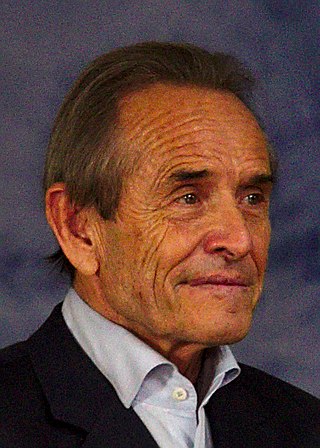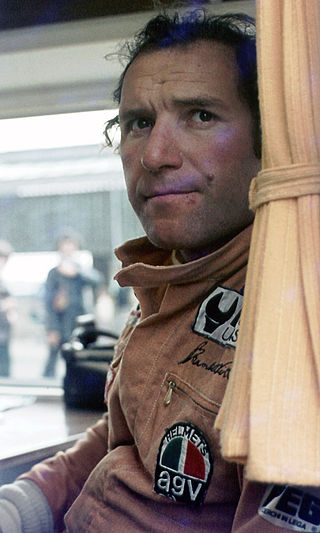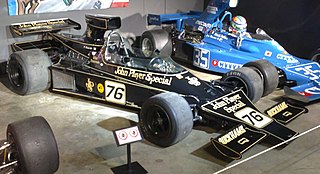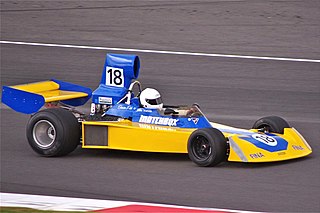Wolf–Williams FW05
Before the start of the 1976 season, Canadian oil millionaire Walter Wolf bought 60% of Frank Williams Racing Cars and the team became Wolf–Williams Racing. However, Frank Williams was retained as team manager. soon afterwards Dr. Harvey Postlethwaite arrived as chief engineer. Simultaneously Wolf bought the assets of the Hesketh team that had recently withdrawn from F1.
The team was based in the Williams facility at Reading but used most of the cars and equipment once owned by Hesketh Racing. The team inherited the Hesketh 308C car used by Hesketh Racing during the final races of 1975, rebranding it as the Wolf–Williams FW05 and the Williams FW04 was similarly rebranded as the Wolf–Williams FW04, although it was only used in the opening race of the season, the 1976 Brazilian Grand Prix. [6]
The team had two new drivers, for Brazil Italian Renzo Zorzi drove the FW04 and Belgian Jacky Ickx drove the FW05. Zorzi outqualified Ickx (17th and 19th), and both cars finished the race with Ickx eighth and Zorzi ninth. After this race, Wolf–Williams had two FW05s at their disposal and so the FW04 was put aside.
However, Zorzi was replaced by Frenchman Michel Leclère for the remaining first half of the season because the Italian's sponsorship funds ran out. At South Africa the Belgian outqualified the Frenchman (19th and 22nd), and both cars finished the race with the Frenchman 13th eighth and the Belgian 16th. [7] Both Drivers failed to qualify for the United States Grand Prix West because the Formula One Constructors Association had decided to limit the field to twenty starters for safety reasons, because of the narrow concrete canyons necessitated by the street layout.
At Spain Ickx outqualified Leclère (21st and 23rd), and both cars finished the race with Ickx seventh eighth and Leclère tenth. The Belgian failed to qualify for his home race, the Belgian Grand Prix and the Frenchman qualified 25th and finished 11th. Ickx failed to qualify for Monaco and Leclère qualified 18th and finished 11th, Wolf–Williams had only one car for the Swedish Grand Prix as Ickx was busy winning the 24 Hours of Le Mans with Gijs van Lennep in a Porsche 936, The Frenchman qualified 25th and retired with engine failure. Ickx returned for the French Grand Prix and outqualified Leclère (19th and 22nd), and both cars finished the race with Ickx tenth eighth and Leclère 13th.
Wolf–Williams had reduced their efforts to one car for Britain because Leclère left the team, Ickx failed to qualify and was fired after the race.
Ickx was replaced by Italian Arturo Merzario and the team still only had one car, The German Grand Prix saw Merzario qualify 21st and the race was red flag on the second lap because Brett Lunger's Surtees and Harald Ertl's Hesketh both hit Niki Lauda's Ferrari. Guy Edwards's Hesketh managed to avoid the Ferrari. All three drivers stopped and tried to get Lauda out of the flames and they were joined by Merzario, who stopped the Wolf–Williams after seeing the wreck. The Italian managed to make the restart but retired on lap three because of brake failure. Merzario retired in Austria and Holland with crashes.
The Italian Grand Prix qualifying session on Friday was wet, so the dry session on Saturday was to provide the field with their best times. After this session, Brett Lunger's Surtees, Merzario and Otto Stuppacher's privately entered Tyrrell had failed to qualify. John Watson's Penske and the McLaren's of James Hunt and Jochen Mass qualified in eighth ninth and tenth positions, but their times were later disallowed due to fuel irregularities.
This meant that their Friday times counted for their grid positions. As a result, these three drivers were the three slowest and were deemed not to have qualified, allowing Lunger, Merzario and Stuppacher on to the grid. Stuppacher had already left the circuit and flown back home to Austria, so could not take his place on the grid. This promoted Hunt back into the 26 qualifiers. Merzario withdrew due to brake problems) and promoted Mass, and later Guy Edwards Hesketh also decided to withdraw in order to let Watson race.
For Canadian Grand Prix Wolf–Williams turned up with New Zealander Chris Amon in a second car but after a spin he was hit by Harald Ertl's Hesketh and both cars seriously damaged. Amon suffered bruising to his legs and choose not to take part in the race and the Italian qualified 24th and retired with a crash.
Amon was replaced by Australian Warwick Brown for the United States Grand Prix East, He qualified 23rd and finished 14th, Merzario qualified 25th and retired with a crash.
For the final race of the 1976 season, in Japan Brown was replaced by Local man Masami Kuwashima, He took part in the first practice session for the race, but proved rather slow. In any case, later that day his sponsors withdrew their financing of the Wolf–Williams deal, and Frank Williams promptly replaced Kuwashima with Austrian Hans Binder for the second practice session and the race itself. In qualifying Merzario 19th and Binder 25th, Both men retired in the race Merzario with a broken gearbox and Binder with a wheel issue. However the problem with the FW05 was the car turned out to be overweight. [8]
At season's end, Wolf decided to restructure the team, removing Frank Williams from the manager's job. Disillusioned, Williams left the team altogether, to set up Williams Grand Prix Engineering with Patrick Head in 1977. Wolf brought 100% of Wolf–Williams Racing after buying the 40% share from Williams and the team became Walter Wolf Racing.


















